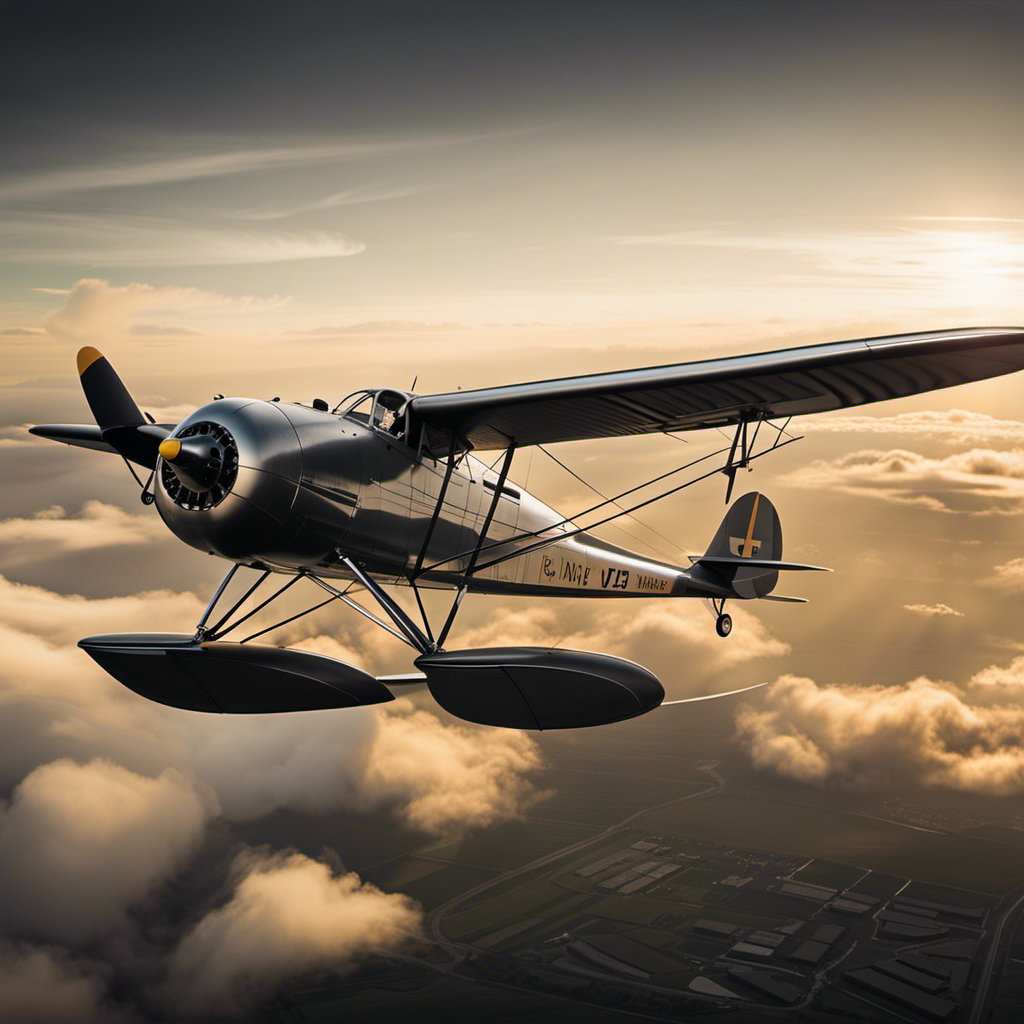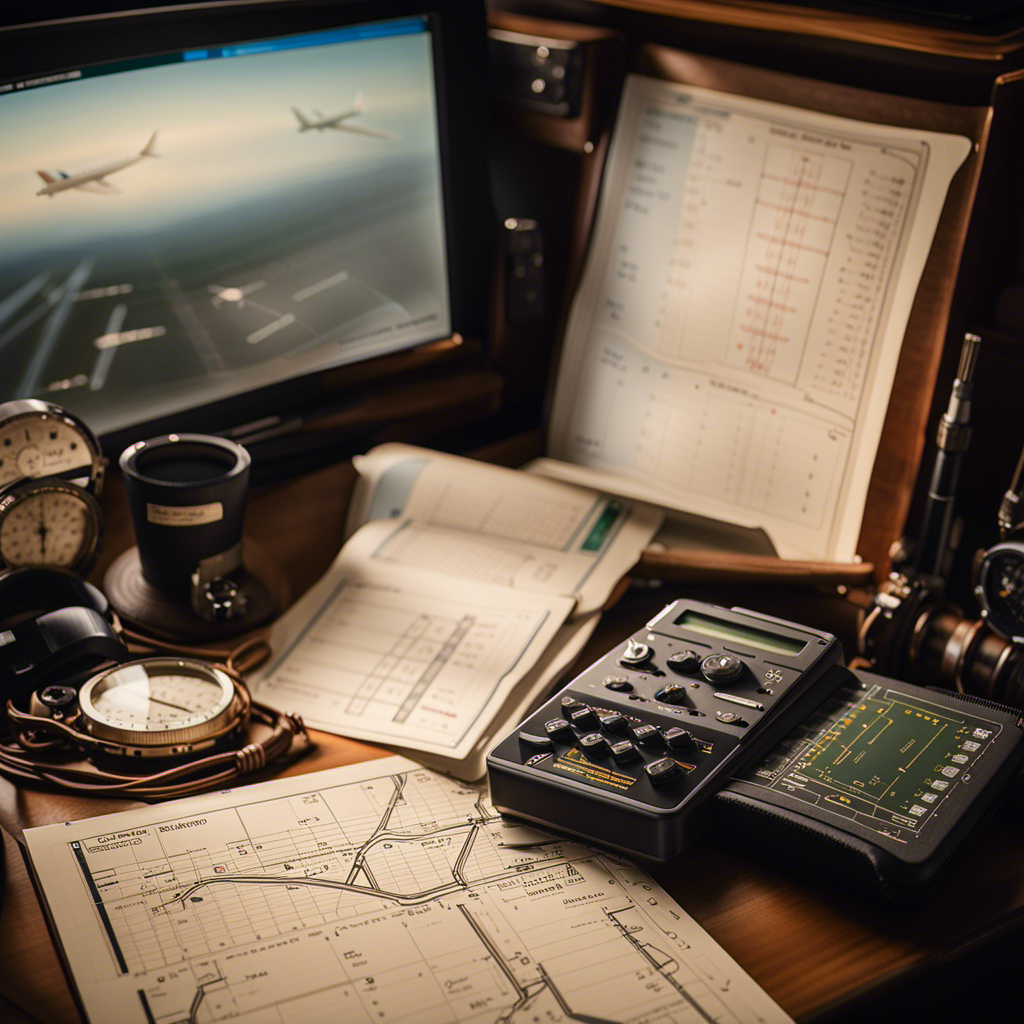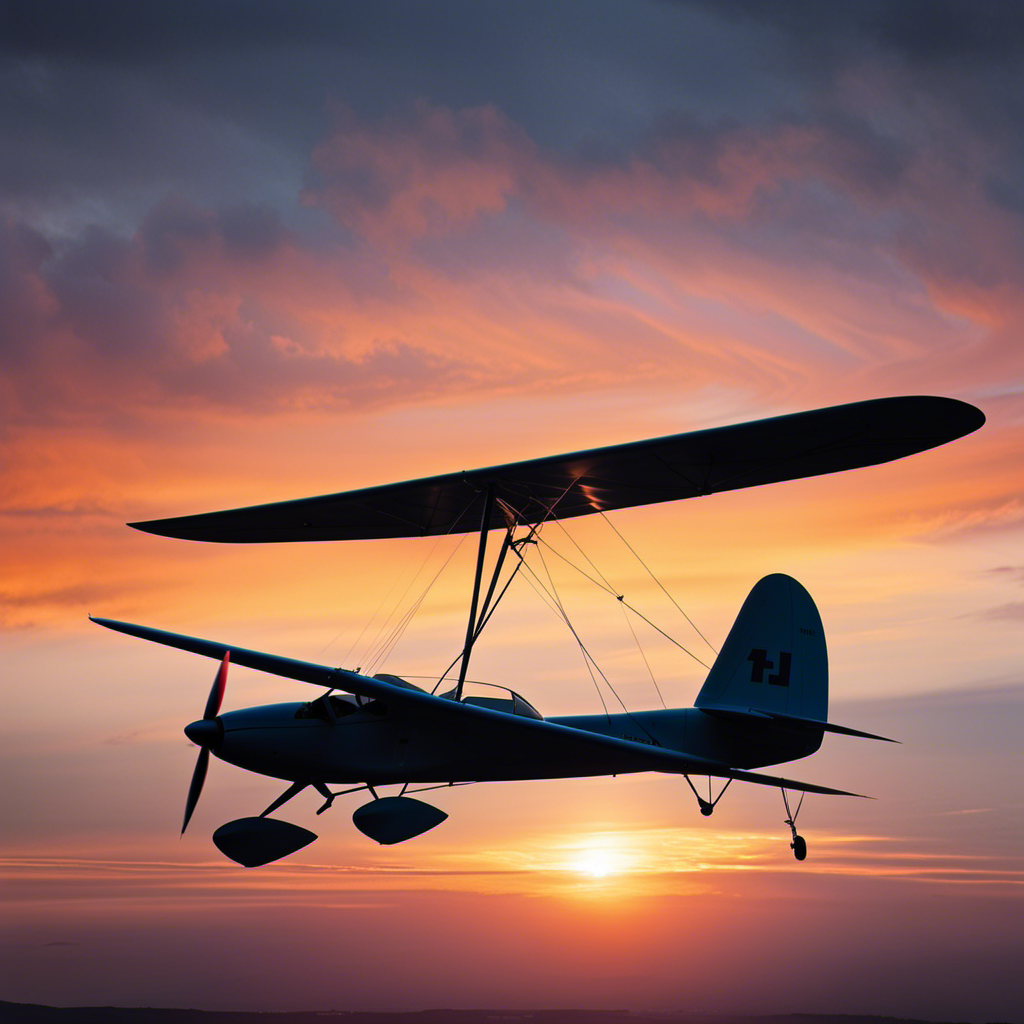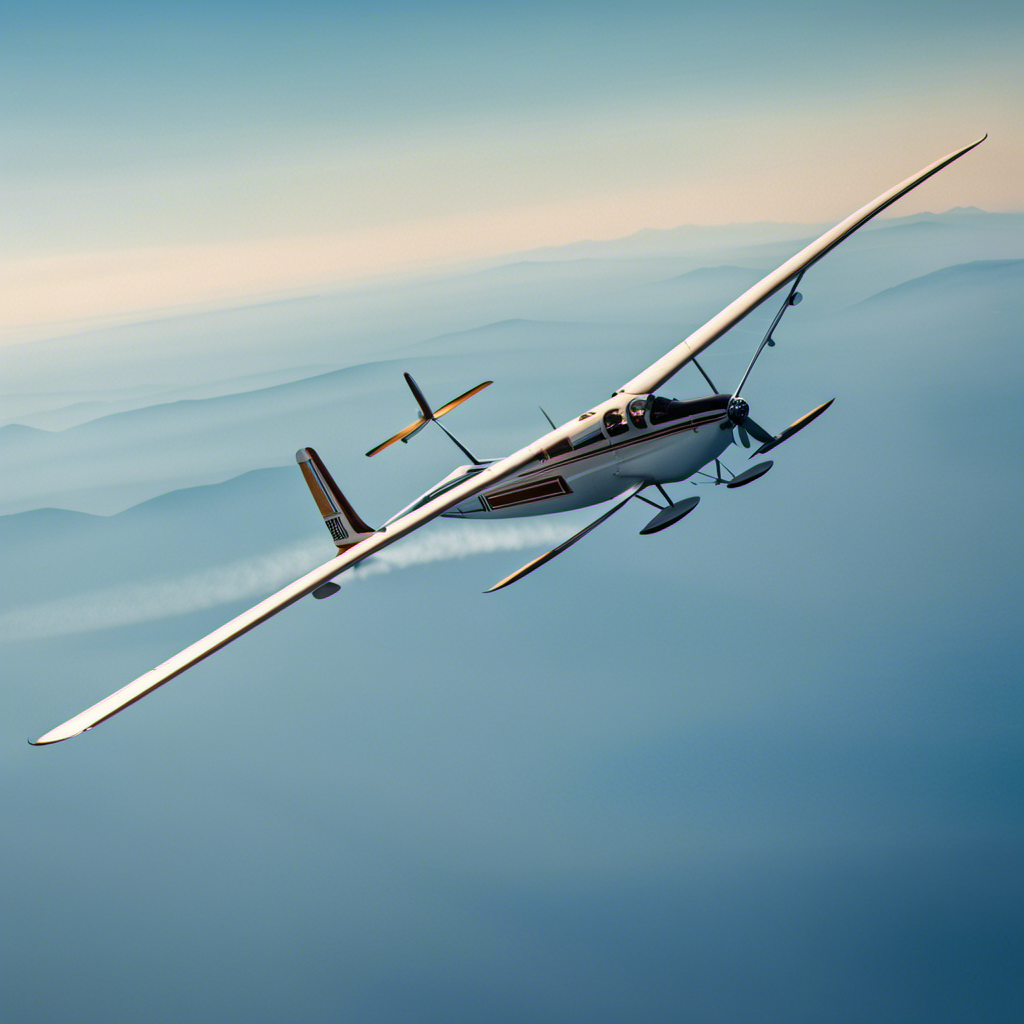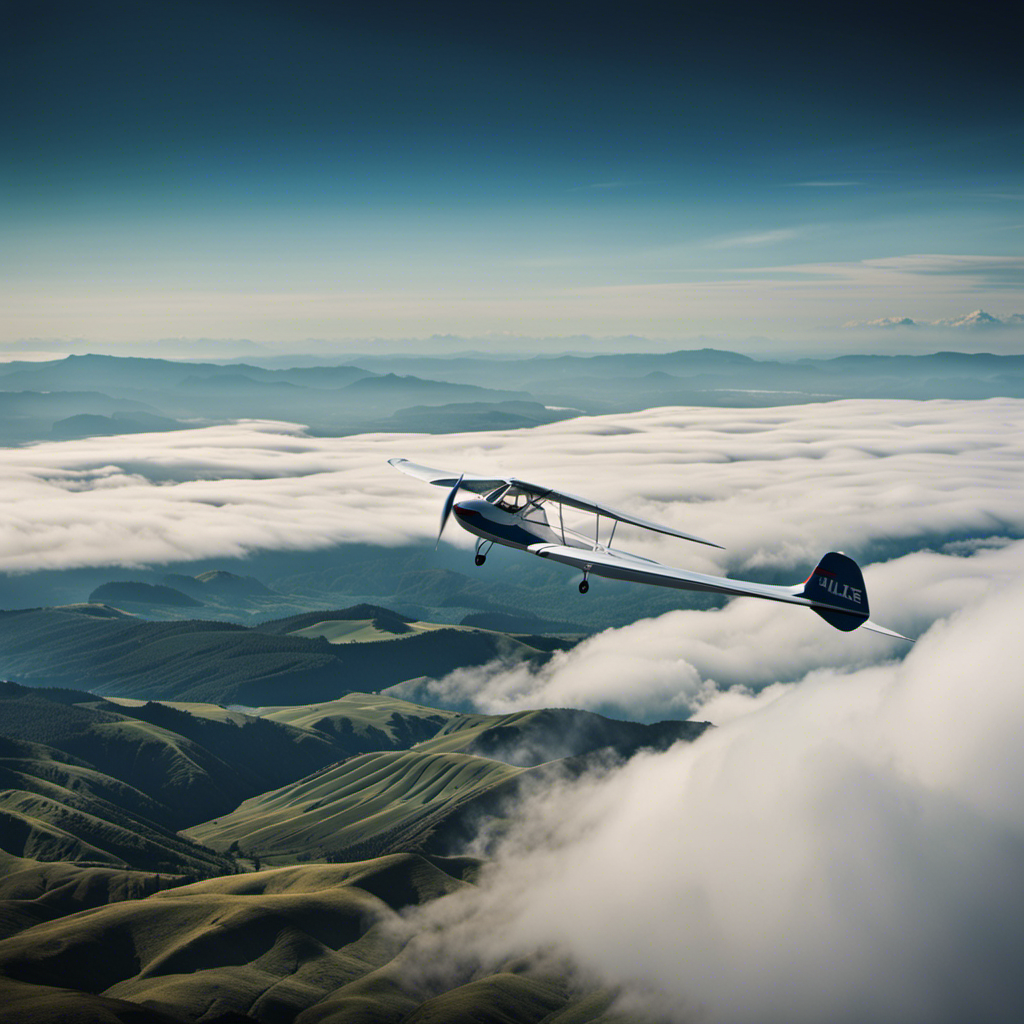As a passionate aviation enthusiast, I am thrilled to share with you the incredible story of the Waco CG-4A, a legendary U.S. glider aircraft used during World War II.
This magnificent aircraft, known for its unique features and specifications, played a crucial role in Allied operations.
But its significance extended far beyond the battlefield, leaving an indelible mark on popular culture.
Through personal stories from courageous glider pilots and a deep analysis of its impact on the outcome of the war, we will remember and celebrate the Waco CG-4A and its unsung heroes.
Key Takeaways
- Glider planes played a crucial role in World War II, revolutionizing tactical warfare with surprise attacks and disruption of enemy defenses.
- The Waco CG-4A was a popular type of U.S. glider plane, produced in large numbers during the war, and known for its versatility, durability, and ability to carry troops and equipment.
- Glider pilots faced numerous challenges and risks, including lack of engine, vulnerability to enemy fire, and the dangerous task of landing in small and heavily defended areas.
- The bravery and skill of glider pilots cannot be overstated, as they played a vital role in Allied operations, contributing to the success of key missions.
The Role of Glider Planes in World War II
In World War II, glider planes played a crucial role in transporting troops and supplies behind enemy lines, allowing us to quickly establish a foothold in enemy territory. The impact of glider planes on military tactics cannot be overstated.
These silent and unpowered aircraft were designed to be towed by larger planes, making them perfect for covert operations. One of the main advantages of using glider planes in these operations was their ability to land undetected, avoiding the noise and visibility associated with powered aircraft. This allowed us to surprise the enemy and launch attacks from unexpected positions.
Additionally, glider planes were able to carry a significant amount of equipment and troops, making them ideal for delivering heavy weaponry and large numbers of soldiers to the battlefield. The use of glider planes in World War II revolutionized military strategies, providing a new way to approach covert operations and establishing a tactical advantage on the battlefield.
This development in military tactics laid the foundation for the subsequent section on the development of glider planes in the United States.
The Development of Glider Planes in the United States
As the United States entered World War II, there was a growing need for airborne assault capabilities. The work of aircraft manufacturers became crucial in developing glider planes that could effectively transport troops and equipment.
One notable creation was the Waco CG-4A, a glider plane that played a significant role in various military operations during the war.
The Need for Airborne Assault Capabilities
During World War II, the U.S. recognized the need for airborne assault capabilities. This led to the development of popular glider planes. Airborne assault tactics became crucial in military operations. They allowed troops and equipment to be swiftly deployed behind enemy lines.
Glider planes were a significant military innovation. They served as a means of transportation for airborne troops and their supplies. These planes were designed to be towed by larger aircraft and then released, gliding silently to their intended landing zones.
The advantage of using glider planes was their ability to conduct surprise attacks. They could approach enemy territory undetected by radar. The use of glider planes revolutionized airborne assault tactics and played a crucial role in the success of various military operations.
This need for airborne assault capabilities paved the way for the work of aircraft manufacturers in developing advanced glider planes.
The Work of Aircraft Manufacturers
You should explore the work of aircraft manufacturers, as they played a crucial role in developing advanced glider planes during World War II.
The advancements in glider technology were made possible through innovative aircraft manufacturing techniques. These manufacturers pushed the boundaries of design and engineering to create glider planes that could carry heavy loads and be launched from great distances. They focused on improving aerodynamics, structural strength, and payload capacity. Additionally, they incorporated new materials and manufacturing processes to ensure the gliders could withstand the demands of combat.
The collaboration between aircraft manufacturers and the military led to the creation of the Waco CG-4A, a widely used glider that played a significant role in airborne assault operations.
The Creation of the Waco CG-4A
The Waco CG-4A, widely used during World War II, was created through collaborative efforts between aircraft manufacturers and the military. This glider plane played a crucial role in various military operations, including the Normandy invasion. The manufacturing process of the Waco CG-4A involved the utilization of advanced technologies and innovative techniques.
- The construction of the glider involved the use of lightweight materials, such as fabric and wood, to ensure maximum maneuverability and efficiency.
- Technological advancements in aerodynamics were incorporated into the design to enhance the glider’s performance and stability during flight.
- The manufacturing process also included the installation of a reliable braking system, which allowed for safe landings in challenging terrains.
By combining the expertise of aircraft manufacturers with the military’s requirements, the Waco CG-4A was developed to meet the demands of aerial transportation and assault missions. This collaboration resulted in a versatile and reliable glider that played a significant role in the success of World War II operations.
Transitioning into the subsequent section about the Waco CG-4A’s features and specifications, it is important to understand the intricate details that contributed to its effectiveness.
The Waco CG-4A: Features and Specifications
One notable feature of the Waco CG-4A glider is its ability to carry up to 13 troops or a Jeep. The Waco CG-4A was produced in large numbers during World War II to meet the demand for glider planes in the United States. Its production began in 1941, and over 13,900 units were built by several manufacturers.
These gliders played a crucial role in the war effort, with many being used for glider pilot training. The CG-4A was well-suited for this purpose due to its simple and rugged design. It had a wingspan of 83 feet and a length of 48 feet, providing enough space for the pilot and trainees to practice various maneuvers.
The glider had a maximum payload capacity of 4,000 pounds, allowing for realistic training scenarios. The Waco CG-4A glider’s versatility and durability made it an ideal training aircraft for aspiring glider pilots during the war. Its significance in Allied operations was not only limited to training, but it also played a vital role in transporting troops, equipment, and supplies during major airborne operations.
The Significance of the Waco CG-4A in Allied Operations
During World War II, the Waco CG-4A glider played a crucial role in Allied operations. Its unique features and specifications made it a popular choice among glider pilots. But what was the significance of the Waco CG-4A in these operations?
The Waco CG-4A made significant contributions to strategic military strategies by being able to transport troops, equipment, and supplies directly into enemy territory. Its ability to land in small, unprepared spaces allowed for surprise attacks and the establishment of vital supply lines.
The Waco CG-4A glider was a symbol of the sacrifices made by glider pilots. These brave men risked their lives flying these fragile aircraft, often in treacherous conditions and under heavy enemy fire. Many of them never returned home, and their bravery is commemorated in memorials across the world.
The significance of the Waco CG-4A extends beyond its operational capabilities. It represents the determination and resilience of the Allied forces, who used every resource at their disposal to achieve victory. The glider pilots who flew the Waco CG-4A demonstrated unwavering courage and played a vital role in the success of Allied operations.
Transitioning into the subsequent section, let us now explore the challenges and risks faced by glider pilots.
Challenges and Risks Faced by Glider Pilots
Transitioning into the subsequent section, let’s now delve into the challenges and risks that glider pilots faced.
Glider pilots encountered numerous challenges and risks during their missions in World War II. One of the biggest challenges was the lack of an engine, which meant that glider pilots had to rely solely on gravity and wind currents to guide their aircraft. This required exceptional skill and precision, as any miscalculation could result in a crash landing.
Additionally, glider pilots faced the constant threat of enemy fire. Gliders were vulnerable targets, with no armor or defensive weapons to protect them. This made them easy targets for enemy aircraft and ground-based artillery.
Furthermore, landing a glider was an incredibly dangerous task. Gliders were often used to land troops and equipment in enemy territory, and the landing zones were frequently small and heavily defended. Pilots had to navigate through enemy fire and avoid obstacles to safely land their gliders.
Despite these challenges and risks, glider pilots played a crucial role in Allied operations, contributing to the success of many key missions.
Transitioning into the subsequent section about the legacy of glider planes in military aviation, it is important to recognize the bravery and skill of these pilots.
The Legacy of Glider Planes in Military Aviation
As you explore the legacy of glider planes in military aviation, you’ll discover their significant impact on strategic operations and the bravery of the pilots who flew them. Glider planes played a crucial role in military history, particularly in World War II, where they were used for tactical warfare. These aircraft, which were unpowered and relied on gravity and the wind to glide through the air, provided a unique advantage on the battlefield.
The significance of glider planes in military history cannot be overstated. They allowed for the transportation of troops and equipment behind enemy lines, enabling surprise attacks and disrupting enemy defenses. The lack of an engine made them quiet and difficult to detect, making them ideal for covert operations. Additionally, glider planes had a much shorter landing distance compared to traditional aircraft, allowing for landings in tight spaces and increasing their versatility.
To better understand the impact of glider planes on tactical warfare, let’s take a closer look at their capabilities compared to traditional aircraft:
| Glider Planes | Traditional Aircraft |
|---|---|
| No engine | Powered by engines |
| Quiet | Loud |
| Short landing distance | Long landing distance |
| Covert operations | Easily detected |
The table above highlights the unique characteristics of glider planes that made them invaluable assets in military operations.
With their ability to silently transport troops and equipment, glider planes revolutionized tactical warfare. They allowed for surprise attacks, infiltration, and the element of surprise. The bravery of the pilots who flew these planes cannot be overstated, as they faced immense risks and dangers during their missions.
Transitioning into the subsequent section about the Waco CG-4A in popular culture, it is fascinating to see how these glider planes have captured the imagination of people beyond the military.
The Waco CG-4A in Popular Culture
When it comes to the Waco CG-4A glider in popular culture, there are several ways in which it has been depicted.
Films and television shows have showcased the glider in various war scenes, highlighting its role in military operations.
Museums and exhibits have also featured the glider, providing visitors with an opportunity to learn more about its history and significance.
Additionally, collectibles and memorabilia related to the Waco CG-4A can be found, allowing enthusiasts to own a piece of this iconic aircraft.
Depictions in Films and Television
The popular type of U.S. glider plane, known as the Waco CG-4, has been depicted in numerous films and television shows. It’s fascinating to see how this iconic aircraft is brought to life on the screen, but it’s important to consider the historical accuracy of these depictions.
While some productions strive for authenticity, others may take creative liberties for dramatic effect.
In the world of media, the Waco CG-4 has been showcased in various ways:
-
In one film, the glider is shown soaring through the sky, gracefully maneuvering over rugged terrain.
-
In a television series, the CG-4 is depicted being used for daring rescue missions, showcasing its versatility and importance in wartime operations.
-
Another production highlights the challenges and dangers faced by glider pilots, emphasizing the courage and skill required to operate these aircraft.
These depictions not only entertain but also help keep the memory of the Waco CG-4 alive. However, for a more accurate understanding, visiting museums and exhibits is a crucial next step.
Museums and Exhibits
Visiting museums and exhibits is a great way to gain a more accurate understanding of the Waco CG-4 and its historical significance. These museum exhibits provide a unique opportunity to see the actual glider and other historical artifacts up close.
I recently had the chance to visit an exhibit dedicated to the Waco CG-4 and was amazed by the level of detail and information available. The exhibit showcased the glider itself, along with photographs, documents, and personal accounts from those who served on these gliders during World War II. It was fascinating to see the craftsmanship and engineering of the glider, as well as learn about its role in various military operations.
These museum exhibits truly bring history to life and allow visitors to appreciate the sacrifices made by those who flew these gliders.
Transitioning into the subsequent section about ‘collectibles and memorabilia’, it’s clear that these museum exhibits can inspire a desire to own a piece of history.
Collectibles and Memorabilia
Owning collectibles and memorabilia from the Waco CG-4 can be a great way to preserve and appreciate the historical significance of these gliders. Collecting glider memorabilia allows enthusiasts to connect with the past and gain a deeper understanding of the glider plane restoration process.
Items such as original flight manuals, patches, and photographs provide valuable insights into the technical aspects and cultural impact of these aircraft. The restoration of glider planes involves meticulous research, sourcing of authentic parts, and skilled craftsmanship. Collecting memorabilia can aid in this process by providing visual references and historical context.
These artifacts serve as tangible reminders of the bravery and ingenuity displayed by glider pilots during World War II. Now, let’s delve into the personal stories and experiences of glider pilots, which shed light on the challenges and triumphs they faced in the skies.
Personal Stories and Experiences of Glider Pilots
When it comes to the personal stories and experiences of glider pilots, there are several key points to consider.
First, the training and preparation that these pilots underwent was rigorous and extensive. From learning how to handle the glider to honing their navigation and communication skills, the training was designed to prepare them for the challenges they would face in combat missions and operations.
Speaking of which, these pilots played a crucial role in various missions and operations during the war, often landing behind enemy lines and providing vital support to ground troops.
Training and Preparation
Before taking to the skies, you’ll need to undergo thorough training and preparation for flying a U.S glider plane. The training methods for glider pilots are designed to ensure that they have the necessary skills and knowledge to safely operate the aircraft. This includes classroom instruction, simulator training, and hands-on experience in the cockpit.
In terms of equipment and gear, glider pilots are provided with a variety of essential items. These include a flight suit, helmet, oxygen mask, parachute, and communication devices. Additionally, glider planes are equipped with instruments and navigation systems to assist pilots during flight.
Overall, the training and preparation process for flying a U.S glider plane is comprehensive and rigorous, ensuring that pilots are well-equipped to handle the challenges of flying these aircraft.
Transitioning into the subsequent section about combat missions and operations, once glider pilots have completed their training and are fully prepared, they are ready to embark on their missions and operations.
Combat Missions and Operations
Once glider pilots have completed their training and are fully prepared, they’re ready to embark on their combat missions and operations. These missions require a high level of skill and training, as glider operations are inherently risky and demanding.
Combat training for glider pilots focuses on honing their navigation skills, mastering tactical maneuvers, and coordinating with ground forces. During actual combat missions, glider pilots play a crucial role in transporting troops, equipment, and supplies into enemy territory. They must navigate through hostile airspace, often at low altitudes, and land their gliders in designated landing zones. These operations require precision, quick thinking, and the ability to adapt to changing situations on the ground.
As glider pilots carry out their combat missions, they contribute to the overall success of military campaigns and help turn the tide of war. Moving forward, let’s explore the impact of these experiences on their lives after the war.
Life After the War
After the war, you’ll have to adjust to a new way of life and find your place in society. Life after the war brought its own set of challenges. Many soldiers returned home to a world that had changed dramatically. Reintegrating into civilian life was not easy. The physical and psychological scars of war lingered, and society struggled to provide the necessary support.
Veterans faced difficulties in finding employment, reconnecting with loved ones, and dealing with the trauma they had experienced. Post-war challenges included housing shortages, economic struggles, and the need for rehabilitation programs. As the world rebuilt itself, individuals had to navigate through this new reality, searching for stability and purpose. Transitioning from the battlefield to civilian life was a complex process, one that required resilience, support, and a willingness to adapt.
The impact of glider planes on the outcome of World War II cannot be underestimated.
The Impact of Glider Planes on the Outcome of World War II
Glider planes played a crucial role in the outcome of World War II, making strategic contributions to Allied victories. These aircraft demonstrated remarkable versatility and flexibility in their operations, effectively transporting troops, equipment, and supplies to the frontlines.
As a result, valuable lessons were learned from the use of glider planes, shaping future military strategies and emphasizing the importance of airborne operations in warfare.
Strategic Contributions to Allied Victories
The glider planes made significant strategic contributions to the Allied victories in World War II.
- Glider pilots played a crucial role in the success of these planes. They were highly skilled and had to navigate challenging terrains and weather conditions. Their ability to land silently and undetected behind enemy lines allowed for surprise attacks and disrupted enemy defenses.
In addition, glider planes played a vital role in amphibious operations.
- They could transport troops, equipment, and supplies directly to the front lines, bypassing enemy defenses. This enabled the Allies to quickly establish beachheads and gain a foothold in enemy territory.
The versatility and flexibility of glider planes were unparalleled. They were able to transport a variety of payloads, from troops to artillery, and were even used for medical evacuations. Their ability to land in confined spaces and their short takeoff and landing distances made them invaluable in both offensive and defensive operations.
Versatility and Flexibility in Operations
Glider pilots’ ability to transport various payloads, navigate challenging terrains, and land in confined spaces made them indispensable in both offensive and defensive operations. Their versatility in combat provided tactical advantages in military operations.
Gliders were capable of carrying troops, equipment, and even vehicles, allowing for swift and covert insertions behind enemy lines. Their ability to fly silently and without an engine made them ideal for surprise attacks and covert missions.
Moreover, gliders could land in remote or confined areas that traditional aircraft couldn’t access, giving them a strategic advantage in reaching isolated targets. The flexibility of gliders proved crucial in various engagements, from the D-Day landings in Normandy to the airborne operations in the Pacific theater.
These lessons learned from glider operations provide valuable insights for future military strategies, emphasizing the importance of adaptability, stealth, and unconventional approaches in achieving success.
Lessons Learned for Future Military Strategies
You can apply the valuable insights gained from glider operations to shape future military strategies. This emphasizes the need for adaptability, stealth, and unconventional approaches in achieving success. Lessons learned from glider operations provide valuable guidance for the development of future military strategies. Here are three key takeaways:
-
Flexibility: Gliders demonstrated the importance of being able to adapt to changing circumstances on the battlefield. Future military strategies should prioritize the ability to quickly adjust and respond to evolving situations.
-
Stealth: Gliders relied on their stealth capabilities to approach targets undetected. Incorporating stealth techniques into future military strategies can provide a significant advantage in surprise attacks and covert operations.
-
Unconventional Approaches: Gliders showcased the effectiveness of unconventional methods and tactics. Thinking outside the box and exploring non-traditional approaches can lead to innovative military strategies that catch adversaries off guard.
Remembering the Waco CG-4A and the Glider Pilots
When it comes to honoring the sacrifices of glider pilots during World War II, there are several ways in which their memory is preserved.
Memorial sites and monuments are erected to commemorate their bravery and the significant role they played in the war.
Commemorative events and ceremonies are also held to pay tribute to these pilots and ensure that their contributions are never forgotten.
It is through these gestures of remembrance that we can truly honor the sacrifices made by glider pilots in the war.
Memorial Sites and Monuments
There’s a memorial site in Normandy that pays tribute to the glider pilots who fought in World War II. This site is just one of many memorial sites and monuments around the world that honor the sacrifices made by these brave individuals.
These memorials serve as a reminder of the courage and dedication of the glider pilots who played a crucial role in the war effort. They provide a place for visitors to reflect on the sacrifices made and to pay their respects.
In addition to these physical tributes, there are also commemorative events and ceremonies held to honor the glider pilots and ensure that their memory lives on. These events bring together veterans, their families, and the community to remember and celebrate the contributions of these unsung heroes.
Transitioning into the subsequent section about ‘commemorative events and ceremonies,’ it is important to note that these events serve as a powerful way to keep the memory of the glider pilots alive.
Commemorative Events and Ceremonies
Commemorative events and ceremonies are a powerful way to honor and remember the bravery of glider pilots in World War II. These events serve as a meaningful tribute to those who risked their lives flying these unique aircraft.
From memorial services to commemorative flyovers, these gatherings bring together veterans, their families, and the community to pay their respects and express gratitude for the sacrifices made.
During these events, stories of valor and courage are shared, highlighting the incredible feats accomplished by these pilots. It is through these gatherings that we can truly appreciate the immense contribution of glider pilots to the war effort.
As we honor the sacrifices of glider pilots, we are reminded of their selflessness and the vital role they played in shaping history.
Honoring the Sacrifices of Glider Pilots
You can honor the sacrifices of glider pilots by attending events and ceremonies that pay tribute to their bravery and selflessness. These gatherings provide an opportunity to learn more about the experiences of these courageous individuals and show appreciation for their contributions during times of war.
Here are three ways you can honor the sacrifices of glider pilots:
-
Attend memorial services: These solemn ceremonies often take place at military cemeteries or memorial sites dedicated to glider pilots. They provide an opportunity to reflect on the sacrifices made by these pilots and pay respects to those who lost their lives.
-
Participate in reenactments: Many historical reenactment groups organize events that showcase the role of glider pilots during significant battles. By participating in these reenactments, you can gain a deeper understanding of the challenges and hardships these pilots faced.
-
Support glider pilot organizations: There are various organizations dedicated to preserving the history of glider pilots and honoring their sacrifices. By joining or supporting these organizations, you can contribute to their efforts in preserving the legacy of glider pilots and ensuring their sacrifices are never forgotten.
Frequently Asked Questions
How many glider planes were used in World War II?
Glider planes played a crucial role in World War II. They were used for various military operations, providing troops and equipment with silent and stealthy landings. Glider pilots were trained to handle emergency situations during landings without engines, relying on skill and precision.
What were some of the other types of glider planes used by the United States during the war?
During World War II, the United States used a variety of glider planes with different types and characteristics. Some of these included the Waco CG-4A, the Airspeed Horsa, and the General Aircraft Hamilcar.
How did glider pilots navigate and land their planes without engines?
Glider pilot training involved learning precise navigation and landing techniques without engines. Pilots relied on visual cues, wind patterns, and their knowledge of the terrain. Challenges included finding suitable landing areas and executing controlled landings to avoid damage.
Were there any notable incidents or accidents involving glider planes during World War II?
During World War II, there were numerous notable incidents involving glider planes. However, advancements in glider plane technology after the war led to significant improvements in navigation and landing techniques.
What advancements or improvements were made to glider planes after the war?
After World War II, advancements in glider plane technology led to improvements in performance. Innovations such as stronger materials, better aerodynamics, and enhanced control systems allowed for higher payloads, longer ranges, and increased maneuverability.
Conclusion
In conclusion, the Waco CG-4A glider plane played a crucial role in Allied operations during World War II. With its ability to silently transport troops and supplies behind enemy lines, it provided a strategic advantage to the Allied forces.
Despite the challenges and risks faced by glider pilots, their bravery and skill contributed to the success of numerous missions.
It is estimated that over 13,900 Waco CG-4A glider planes were built during the war, highlighting their widespread use and significance. This statistic demonstrates the sheer scale and impact of glider planes in the outcome of World War II.
With a heart that soars as high as the skies, Aria, affectionately known as “Skylark,” is the driving force behind Soaring Skyways. Her journey into the gliding world began as a young dreamer gazing up at the soaring birds, yearning to experience the weightlessness and freedom they embodied. With years of experience both in the cockpit and behind the scenes, Aria’s commitment to the gliding community is unwavering.
